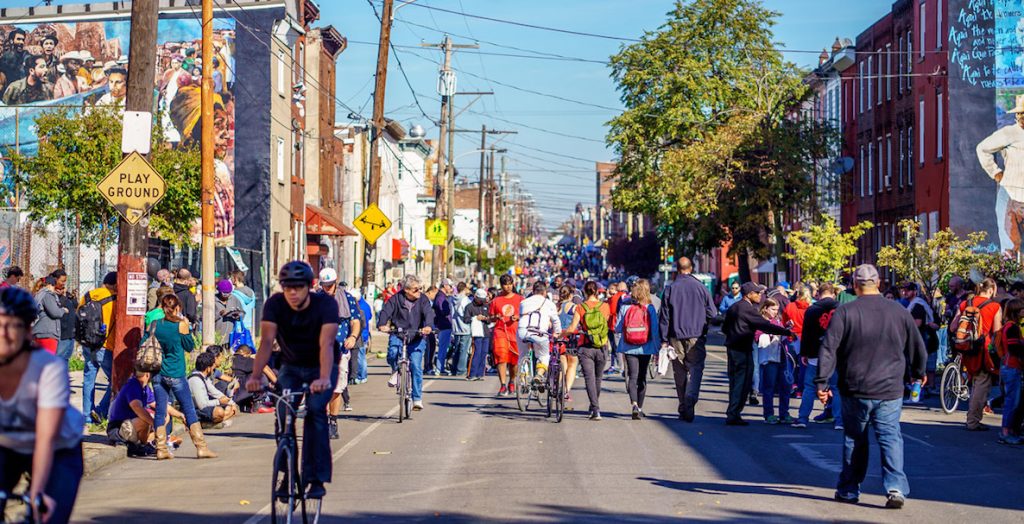Focusing on sustainable mobility
As a solution to heavy traffic in the center, followed by a lack of attractiveness in the central area, cities nowadays are turning their traditional streets into pedestrian thoroughfares, this way claiming city’s streets for people. Jane Jacobs, a journalist and great activist that influenced the urban studies of the 20th century, described streets as “a sidewalk ballet”, a dance between people interacting and depending on each other. Moreover, she fought against the popular practices of that time that put the architects and urban planners in charge of the design and development of the cities. Instead, she observed the tendencies and people’s behavior in the public space, and supported the idea of places where people can live, work and play, in the detriment of streets filled by cars.
“Will the city be any fun?” was one of the questions she asked in 1958, and it seems like cities are making moves towards finding answers to this crucial inquiry.
Strøget

One of the most popular examples of such practice, where space used by cars was given back to people is Strøget, the main shopping street in the center of Copenhagen (and one of the longest in the world).
At that time, when Jan Gehl proposed its pedestrianization, the idea was controversial and met skepticism, most of the people arguing that Danes did not have a mentality of public life and moreover, the local merchants felt their business was threatened by such a change. However, the street proved to be a success and a fine example for others to implement such practices, including the City of Copenhagen which continued its transformation from a car-oriented into a pedestrian-oriented city.
See Urban Talks: Cars vs. People – Is your city ready for the future?
New cities adding pedestrian streets
Brussels is redeveloping its main boulevard, Boulevard Anspach and its afferent squares. This is an ambitious project that aims to improve the quality of life by encouraging an urban design that embraces nature and affords people a variety of activities. Some of the most important interventions are: renovation of facades, implementation of green areas such as flowerbeds or flower plantations accessible to everyone, urban furniture and lightning facilities for a safer environment. On top of that, the revitalization of this space is also meant to fight and reduce the air and noise pollution, by offering a greener, healthier and more breathable public space to satisfy citizens’ well-being.
As far as mobility is concerned, the design managed to ensure that wherever you are in this area, you will be 4 minutes away from a car parking, Villo station or public transport stop.

Fountain Square
This square will become a green link between the Saint-Jacques neighborhoods, Jardin aux Fleurs, Lemonnier, Anneessens and its new park. It will be a place for people to relax, sunbath, take a stroll from one neighborhood to another.

Boulevard Anspach
This boulevard will be designed in three areas: the pedestrian and emergency area in the center, followed by two areas of green space and sidewalks along the facades.

Place de la Bourse and the Stock Exchange
These are iconic places in Brussels, both declared UNESCO World Heritage Sites. An important element in their future development will be water, as there will be a fountain and a water mirror for children to play but also for a cooling effect in summer.

Place de Brouckère
This plaza will become an open space with a new, blue and durable pavement. The aim is to convert this space into an “Agora” of the city, therefore the access to the metro will be closed and replaced by new access on the boulevard Adolphe Max, where there will also be implemented a generous bike parking.
Watch here in virtual reality.
Edinburgh is also putting people at the core of its city center urban transformation. The city is the fastest growing in Scotland, therefore it needs to change and adapt by prioritizing people over vehicles.

What is even more interesting, is the fact that the City of Edinburgh Council has launched a consultation platform so that people can share their opinion regarding a permanent conversion of car streets into pedestrian streets. This is an example of bottom up initiative, when the authorities actually take into consideration citizens’ opinion, supporting them into shaping their cities.
One of the first initiatives in order to test this new approach will be to close the selected streets to traffic on the first Sunday of every month and open them to public. However, the process will be longer but with support and citizens’ involvement (which already voted for change), Edinburgh can achieve the status of an active city which works for everyone, prioritizing people that travel on foot, bike or public transport. On top of that, green areas and open spaces will also be implemented in order to create a better, more sustainable environment and an attractive public space.
This trend is starting to become more popular, in Europe but also in the USA. However, there are still many cities that consider car traffic to be the most important flow on their main streets, and it will take time to change mentality in that sense. That is why people have to find a way of becoming active and express their wills regarding the future of their cities. After all, who doesn’t want streets that afford various activities and create a sense of community?
Photos: The Philadelphia Citizen, centreville.bruxelles.be, www.edinburgh.gov.uk
Text: centreville.bruxelles.be, www.vox.com, www.edinburgh.gov.uk






